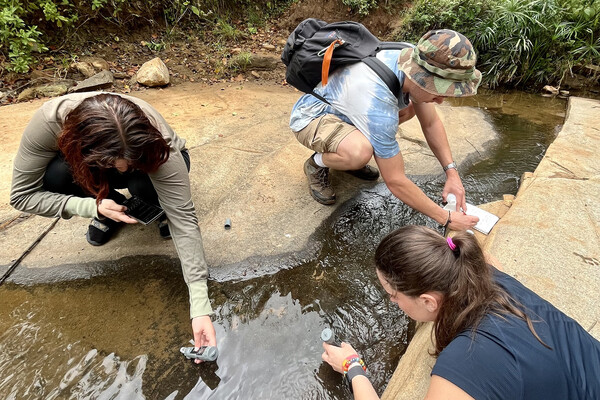
Griffin Pitt, right, works with two other student researchers to test the conductivity, total dissolved solids, salinity, and temperature of water below a sand dam in Kenya.
(Image: Courtesy of Griffin Pitt)
2 min. read
The most common side effect of mRNA vaccines like the COVID-19 shot is inflammation: soreness, redness, and a day or two of malaise. Now, researchers at Penn’s School of Engineering and Applied Science have redesigned the process to sidestep the side effects.
In a new paper in Nature Biomedical Engineering, researchers in the Mitchell Lab show that tweaking the structure of the ionizable lipid, a key component of the lipid nanoparticles (LNPs) that deliver mRNA, not only reduces inflammation but also boosts vaccine effectiveness for preventing or treating a range of diseases, from COVID-19 to cancer.
The key change entails adding phenol groups, chemical compounds with anti-inflammatory properties famously found in foods like olive oil. “By essentially changing the recipe for these lipids, we were able to make them work better with fewer side effects,” says Michael J. Mitchell, associate professor in bioengineering and the paper’s senior author. “It’s a win-win.”
Until now, the ionizable lipids in LNPs have largely been synthesized using chemical reactions that combine two components into a new molecule. “Because these processes have been so successful, there hasn’t been much effort to look for alternatives,” says Ninqiang Gong, a former postdoctoral fellow in the Mitchell Lab and co-first author of the paper.
The team found an alternative approach in the Mannich reaction; rather than two components, the Mannich reaction combines three precursors, allowing for a greater variety of molecular outcomes. “We were able to create hundreds of new lipids,” says Gong.
Exploring that “library” of lipids led the team to discover that adding a phenol group—a combination of hydrogen and oxygen connected to a ring of carbon molecules—substantially reduced inflammation.
Read more at Penn Engineering Today.
Ian Scheffler

Griffin Pitt, right, works with two other student researchers to test the conductivity, total dissolved solids, salinity, and temperature of water below a sand dam in Kenya.
(Image: Courtesy of Griffin Pitt)

Image: Andriy Onufriyenko via Getty Images

nocred

Provost John L. Jackson Jr.
nocred